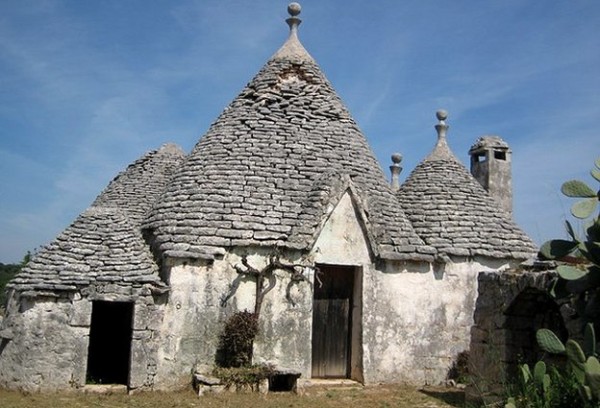
The latest property of choice for holiday home buyers in Southern Italy is not a rustic villa or a rambling farmhouse – it is a former farmer’s shed, which would not look out of place on the set of Lord of the Rings.
Trulli are the trademark of Puglia – existing nowhere but the Valley of Itria. Round limestone buildings with conical roofs, they are as magical as they are historical. Dotted across the landscape, alone or in clusters, with one cone or even a dozen, they look like miniature rustic fairytale castles – Asterix meets Disney.
Originally nothing more than farmers’ sheds used to store equipment or animals, the structure is made with the same drystone technique as the low walls that demarcate the olive groves. No cement, just local limestone cut into large, heavy slabs called chiancarelle – carefully positioned to make the perfect water-tight structure.
It is said that back in the 1600s, when there was a tax on new buildings, the locals built trulli so they could be dismantled when the inspectors came and rebuilt after they had gone.
In between viewings estate agent, Alessandro Melpignano tells us enthusiastically about the trullo revival. They became trendy holiday homes when the Trulli of Alberobello became a Unesco world heritage site in 1996.
“That is when the market really exploded”, he explains. The first to buy were the Germans, who soon got fed up with break-ins. The British were hot on their heels.
“But they have stayed,” says Melpignano. “And they are still buying. Low-cost flights to Bari and Brindisi have helped keep them coming.”

Trulli need renovating every 100 to 150 years. It takes around a month to rebuild a cone and costs about 15,000 euros (£12,700). Do they have experts who renovate and rebuild trulli? “Oh yes,” he grins. “They are called trullari. And I know a master trullaro.”
The next morning I go in search of Giovanni d’Errico and find him, unsurprisingly, building a trullo. If anybody ever looked the part, it is d’Errico, who bears an uncanny resemblance to a Hobbit.
He tells me he has always been passionate about trulli, but when he was young, nobody cared about them. “They were mostly abandoned ruins. People saw them as hovels for the poor.”
“I became a trullaro about 20 years ago. Before that I was a tiler. When I began, there was just one trullaro left in this area. It was a dying trade. Now there are loads of us.”
I wonder if d’Errico thinks tourists are mad for falling in love with old farmers’ sheds? On the contrary, he says he is supremely grateful. “They gave us work and a bit of well-being – they brought our abandoned land back to life.
“Even if it has slowed down with the recession and heavy taxes on homeowners, our profession’s still growing. I do not make a fortune but I do love my job. It is a beautiful thing that everyone wants a trullo.”

According to Giuseppe Miccolis, another master trullaro specialising in historic trulli, “the problem is that anyone can set himself up as a trullaro without any formal training or qualification”.
Miccolis, who comes from a long line of trullari, was born into the profession. “At the age of three, I used to play with the stones. At 14 I started working.”
He considers his trade an art and a passion. But it is tinged with disappointment and frustration. “It is not just the unskilled self-styled trullari, it is the people who build illegally without respecting our landscape.”
Nevertheless, Giuseppe is determined to preserve his beloved traditional craft. He has begun taking school children on walks, visiting historic trulli and explaining and demonstrating how they are built.
“I am hoping to inspire local kids to develop the passion my family passed on to me. I am going to organise walks for tourists too,” he says. “Why don’t you come back for one?” My eyes light up. “When?”
The Trulli of Alberobello
“It is one of the best preserved… urban areas of this type in Europe. Its special features, and the fact that the buildings are still occupied, make it unique.
“It also represents a remarkable survival of prehistoric building techniques.
“Tradition has it that drystone walling was imposed upon the new settlers so their houses could be quickly dismantled. This served two purposes: recalcitrant householders could be dispossessed easily and, later, it would be possible to avoid taxation on new settlements. In the latter case the buildings could be reconstructed equally rapidly.”




Leave a reply